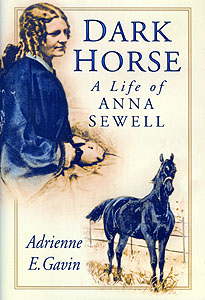

BOOK REVIEW
Dark Horse, A Life of Anna Sewell
Author: Adrienne E Gavin
Review by Diana Kennedy
This article was originally published in the August 2004 edition of Soul Search, the journal of The Sole Society
 Using
recently discovered letters and other sources Adrienne Gavin has written the
first biography of Anna Sewell for over thirty years, on the 125th
anniversary of her death.
Using
recently discovered letters and other sources Adrienne Gavin has written the
first biography of Anna Sewell for over thirty years, on the 125th
anniversary of her death.
Little was recorded of Anna's life and most of the information known about her has come from the accounts of the life of her mother Mary Sewell, a noted Victorian author. Adrienne Gavin has used extracts from letters written by Anna and her family that can be found in the Norfolk Record Office.
Anna Sewell was born in Great Yarmouth, Norfolk on 30 March 1820 to Isaac Sewell and his wife Mary neé Wright. Mary was a strong-minded independent woman responsible for educating Anna and her brother Philip. While her mother Mary was a well known author of the time, Anna wrote only one book, Black Beauty, written over six years, at the end of her life. Black Beauty was finally published in 1877, but Anna died five months after it was completed, not living to see the great success of her book. The biographical details are probably well known to Sewell researchers but this biography offers a greater insight into the life of Anna and her family as well as life in the nineteenth century.
Throughout her biography, Adrienne Gavin shows how important religion was to the family. Both Mary and Isaac came from Quaker families and, although Anna, her mother and brother all left the Quakers, religion had a profoundly important effect on Anna's life. The Quaker traditions of good works were important to the family and Anna and her mother became involved in practical charity work, particularly teaching, wherever they lived.
Despite moving many times, family and community were important. Anna spent much of her life battling with her faith, she and her mother tried several religious sects. Even so a strong religious outlook underpinned their lives. She wrote `I thank God for my lameness, I am sure it is sent in love, though it is a trial'. Her father Isaac remained strong in his Quaker faith while Philip became a staunch member of the Church of England.
The book offers an insight into the illness that was to affect Anna's life. This followed an accident at the age of fourteen when Anna slipped and sprained her ankle. The twisted ankle refused to heal, precipitating a mystery illness that dogged her life. The author has sought medical opinion and suggests that it is likely that Anna was suffering from a severe form of Lupus, Systemic Lupus Erythematosis, a disease unknown at the time. Lupus is a chronic auto-immune disease, where the body attacks it own organs. Periods of remission were followed by acute pain, when Anna was often unable to walk or even stand. Her parents sought many cures for her, including pills and potions, homeopathy and water cures.
It was at one of these water cures in the 1840's that Anna met the poet Alfred Tennyson while staying at the same hotel. Anna's niece Margaret Sewell recounts they spent some time together walking and talking together and he gave her a signed photograph of himself. They probably had much to talk about as Anna, like her mother, enjoyed reading and poetry.
Because of her lameness Anna became a skilled horsewoman at riding and driving horses. She drew on her knowledge of horses, people and places as well as her imagination when she came to write Black Beauty. Anna Sewell wrote that her aim in writing Black Beauty was `to induce kindness, sympathy and an understanding treatment of horses.' It was not originally written as a children's book but rather for those who dealt with horses. It was to become one of the best selling novels ever written. Animal welfare groups distributed thousands of copies free to stable hands and drivers. It was translated into Arabic, Chinese, Japanese, Hindustani, Turkish and Braille as well as European languages. Black Beauty has been compared to Uncle Toms Cabin by Harriet Beecher Stowe. It is one of the few novels that can claim to reduce suffering.
Due to the business problems of her father Isaac, the family moved house several times, living in London, Sussex, Gloucestershire, and Somerset as well as Norfolk. Adrienne Gavin gives an insight into the places where Anna lived and how life was lived in the nineteenth, as well as events that occurred that Anna may have witnessed. Unfortunately there is little left to commemorate her life, even her gravestone was destroyed in 1984.
A Dark Horse is beautifully written, well researched and a delight to read. It is of interest for those interested in the era even if they have little interest in the Sewell name. There is a useful index and notes with a family tree of the Sewell's and the Wrights as well as several photographs.
Dark Horse A Life of Anna Sewell, Published by Sutton Publishing Ltd 2004, hardback edition at £20